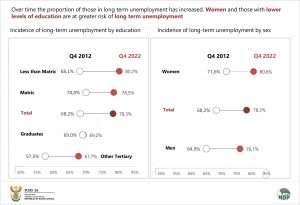Incidence of long-term unemployment among women is higher than the national average.
South Africa’s unemployment rate decreased by 0,2 of a percentage point to 32,7% in Q4:2022 compared to Q3:2022. According to the Quarterly Labour Force Survey (QLFS) for the fourth quarter of 2022, there were about 28 thousand more people who were unemployed than in Q3:2022.
In the fourth quarter of 2022, South Africa had 7,8 million persons who were without work, looking for work and available to work, of which 6,1 million were in long-term unemployment and 1,7 million in short-term unemployment. Findings from Q4:2022 show that long-term unemployment has almost doubled since Q4:2012, while short-term unemployment has increased by 0,2 million persons.
Unemployment levels are persistently higher post-2016, reaching a peak in Q4:2021 with 7,9 million unemployed persons. During the same period, long-term unemployment also recorded its highest point (6,3 million) while short-term unemployment reached its peak of 2,0 million in Q4:2020, during the national lockdown. Almost four out of five (78,3%) unemployed persons have been without work, looking for work and available for work for a year or longer. Less than one out of five (21,7%) unemployed persons were in short-term unemployment.
The International Labour Organisation (ILO) defines short/long-term unemployment as the duration an unemployed person has been without work, looking for work and available for work. While short-term unemployment refers to unemployment of less than a year, long-term unemployment refers to unemployment of a year or more. Apart from other factors such as low level of education and lack of experience, long-term unemployment negatively affects the employability of unemployed persons while short-term unemployment provides time for job seekers to find favourable employment1. The effects of long-term unemployment are more likely to result from structural problems in the labour market due to a mismatch between supply and demand for labour, i.e. jobs may be available in the labour market but the skills the unemployed possess are not what is demanded by employers. Reducing the duration of unemployment is vital to reducing the overall unemployment rate.
In terms of long-term unemployment disparities exist by, but not limited to, sex and education level. In a global sense, higher levels of unemployment mostly affects women and people with lower levels of education.
Women are the most vulnerable in the labour market. Compared to men, women are more likely to remain unemployed for longer periods, which eventually affects their chances of being employed in the future. In this respect, in Q4:2022, 80,6% of women were in long-term unemployment compared to their male counterparts with 76,1%. The incidence of long-term unemployment among women has consistently been higher than the national average. Although men recorded the highest increase in the incidence of long-term unemployment, the incidence among women was higher in 2012 and 2022.
Level of education plays a vital role in the employability of unemployed persons in the labour market. Generally, persons with the highest level of education are less likely to be affected by high levels of unemployment. The findings suggest that unemployed persons with less than a matric level of education and matric qualification have a higher likelihood of being in long-term unemployment as opposed to tertiary and other tertiary qualifications. A possible reason for this might be a lack or shortage of necessary skills required to meet the demand in the labour market. Conversely, persons who pursue higher education careers are more likely to increase their employability and boost their success in the labour market.
The World Bank’s thirteenth edition of the South Africa Economic Update, “Building back better from COVID-19”, with a special focus on jobs, identified underlying factors or parts of the labour market that South Africa can leverage to be able to halve high levels of unemployment2. It has argued that, given the small percentage of self-employment in the country, the government should focus more on supporting entrepreneurship and self-employment since they provide opportunities for job creation in South Africa.
For more information, download the full report here.
1https://www.ilo.org/wcmsp5/groups/public/—dgreports/—dcomm/documents/briefingnote/wcms_767028.pdt ILO Monitor: COVID-19 and the world of work. Seventh edition
2https://www.worldbank.org/en/country/southafrica/publication/south-africa-economic-update-south-africa-s-labor-market-can-benefit-from-young-entrepreneurs-self-employment World Bank: South African Economic Update: Building back better from Covid19, with a special focus on jobs



